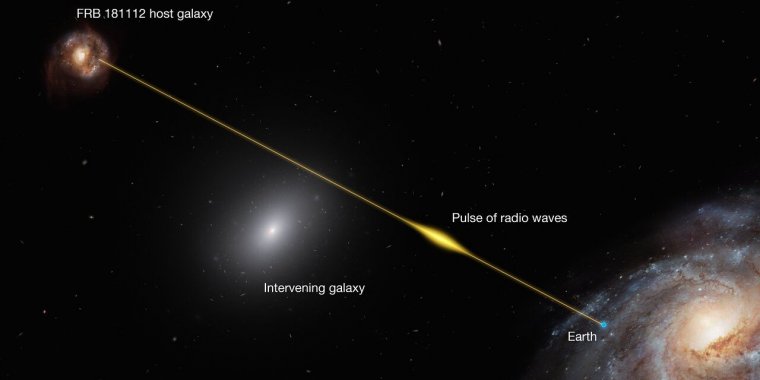| News / Space News |
Enigmatic radio burst illuminates a galaxy’s tranquil halo
Using one cosmic mystery to probe another, astronomers analysed the signal from a fast radio burst to shed light on the diffuse gas in the halo of a massive galaxy.

Infographic showing the path of FRB 18112 passing through the halo of an intervening galaxy. Photo: ESO/M. Kornmesser
In November 2018 the Australian Square Kilometre Array Pathfinder (ASKAP) radio telescope pinpointed a fast radio burst, named FRB 181112. Follow-up observations with ESO’s Very Large Telescope (VLT) and other telescopes revealed that the radio pulses have passed through the halo of a massive galaxy on their way toward Earth.
This finding allowed astronomers to analyse the radio signal for clues about the nature of the halo gas.
“The signal from the fast radio burst exposed the nature of the magnetic field around the galaxy and the structure of the halo gas. The study proves a new and transformative technique for exploring the nature of galaxy halos,” said J. Xavier Prochaska, professor of astronomy and astrophysics at the University of California Santa Cruz.
Astronomers still don’t know what causes fast radio bursts and only recently have been able to trace some of these very short, very bright radio signals back to the galaxies in which they originated.
“When we overlaid the radio and optical images, we could see straight away that the fast radio burst pierced the halo of this coincident foreground galaxy and, for the first time, we had a direct way of investigating the otherwise invisible matter surrounding this galaxy,” said coauthor Cherie Day, a PhD student at Swinburne University of Technology, Australia.
A galactic halo contains both dark and ordinary—or baryonic—matter that is primarily in the form of a hot ionised gas. While the luminous part of a massive galaxy might be around 30 000 light years across, its roughly spherical halo is ten times larger in diameter.
Halo gas fuels star formation as it falls towards the centre of the galaxy, while other processes, such as supernova explosions, can eject material out of the star-forming regions and into the galactic halo.
The signal of FRB 181112 was comprised of a few pulses, each lasting less than 40 microseconds (10 000 times shorter than the blink of an eye). The short duration of the pulses puts an upper limit on the density of the halo gas because passage through a denser medium would broaden the duration of the radio signal.
The researchers calculated that the density of the halo gas must be less than 0.1 atoms per cubic centimeter (equivalent to several hundred atoms in a volume the size of a child’s balloon).
“Like the shimmering air on a hot summer’s day, the tenuous atmosphere in this massive galaxy should warp the signal of the fast radio burst. Instead we received a pulse so pristine and sharp that there is no signature of this gas at all,” said coauthor Jean-Pierre Macquart, an astronomer at the International Center for Radio Astronomy Research at Curtin University, Australia.
The study found no evidence of cold turbulent clouds or small dense clumps of cool halo gas. The fast radio burst signal also yielded information about the magnetic field in the halo, which is very weak—a billion times weaker than that of a refrigerator magnet.
At this point, with results from only one galactic halo, the researchers cannot say whether the low density and low magnetic field strength they measured are unusual or if previous studies of galactic halos have overestimated these properties. (ESO)
YOU MAY ALSO LIKE





